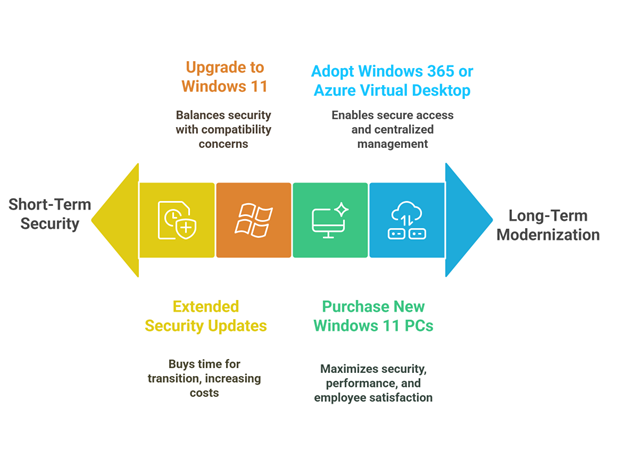Extend Your Windows 10 Security: ESU Solutions Backed by Apps4Rent
Microsoft has confirmed that support for Windows 10 will end on October 14, 2025. After this date, the operating system will no longer receive regular security patches, feature updates, or technical support. While devices running Windows 10 will continue to function, the lack of updates will gradually weaken their defenses, increasing the risk of malware, ransomware, and other cyber threats.
For organizations handling sensitive data or required to meet compliance regulations, the consequences extend beyond security risks. Continuing to use unsupported software can lead to audit failures, policy violations, and disruptions in operations. Microsoft recommends migrating to Windows 11, which offers enhanced security, improved performance, and extended support.
However, not all organizations are prepared to upgrade immediately. Legacy applications, hardware limitations, and transition time may require a more gradual approach. Microsoft offers Extended Security Updates (ESU) as a temporary solution for these businesses, ensuring continued protection for qualifying devices until a more permanent upgrade can be implemented.
Choosing the Right Path Forward After Windows 10 End of Life
With Windows 10 support ending in October 2025, organizations must decide how to move forward securely. Whether modernizing infrastructure, maintaining compatibility with legacy systems, or ensuring compliance, your choice will depend on specific needs. Consider the following options:
-
Upgrade to Windows 11
Upgrading to Windows 11 is Microsoft’s recommended option for most organizations, offering advanced hardware-based security features like Trusted Platform Module (TPM) 2.0 and Secure Boot to defend against modern threats. Windows 11 also introduces productivity-enhancing tools such as Snap Layouts and Virtual Desktops. Before upgrading, however, it’s essential to ensure compatibility with existing software and verify that your devices meet the hardware requirements, which may necessitate new equipment. While this presents an additional cost, it offers the opportunity to modernize your hardware and improve system performance.
-
Use Extended Security Updates (ESU)
For organizations not yet ready to transition, Microsoft’s Extended Security Updates (ESU) provide a temporary solution by continuing critical security patches post-support. ESUs are particularly useful for businesses relying on legacy systems or applications, allowing time to complete an upgrade or migration. The program lasts for up to three years, though costs increase annually, making it a short-term measure. Organizations should use this time to plan a transition to Windows 11, invest in new hardware, or explore cloud-based alternatives.
-
Purchase New Windows 11 PCs
Investing in new Windows 11-compatible devices is a forward-thinking strategy that ensures full access to Windows 11’s capabilities, including enhanced security, performance, and reliability. Modern hardware also supports security and energy-efficiency standards, reduces maintenance costs, and supports broader IT modernization goals. This approach also contributes to employee satisfaction and productivity by providing up-to-date tools.
-
Adopt Windows 365 or Azure Virtual Desktop
Cloud-based solutions like Windows 365 and Azure Virtual Desktop provide flexibility and centralized management. These platforms enable secure access to legacy applications in a virtual environment, eliminating the need for local hardware upgrades. Suitable for hybrid or distributed teams, they offer a scalable, always-up-to-date infrastructure. Virtual desktops modernize IT environments with minimal disruption, extending access across devices while maintaining security and compliance.

Understanding Extended Security Updates (ESU) for Windows 10
As Windows 10 nears its end-of-support date, the ESU program provides a temporary solution for businesses needing more time to transition. ESUs offer critical security patches beyond the official support cutoff, focusing only on security updates without any feature or performance improvements.
The program serves as a bridge for organizations, maintaining essential protection against threats while they prepare to migrate to Windows 11 or other supported platforms. However, ESUs are not a long-term solution; they are designed to help businesses during the transition period.
It’s important for organizations to treat the ESU program as a short-term measure and prioritize planning for a permanent upgrade or migration strategy to ensure continued security and compliance in the future.
Eligibility and Purchase Process for Extended Security Updates (ESU)
ESUs are available for Windows 10 Enterprise and Professional editions. To access them, organizations can purchase through the Volume Licensing Service Center (VLSC) or Microsoft Cloud Solution Providers (CSPs) like Apps4Rent. The cost follows a tiered structure, increasing annually, encouraging businesses to plan their migration early to avoid higher costs. ESUs should be viewed as a temporary solution while businesses transition to supported platforms.
Risks of Not Addressing Windows 10 End of Support
As the end-of-support date for Windows 10 approaches, businesses that delay transitioning to a supported system face several risks. These include:
- Security Exposure: Unsupported systems become prime targets for cyberattacks due to the lack of security updates. Vulnerabilities in outdated systems can be easily exploited by hackers, putting sensitive data at risk.
- Compliance Violations: Organizations in regulated industries may face compliance risks by continuing to use outdated software. Non-compliance with industry regulations could result in legal penalties or loss of certifications.
- Operational Instability: As new technologies are introduced, unsupported systems may encounter compatibility issues, performance problems, or even system failures. These disruptions can impact business operations, reduce productivity, and increase IT costs.
- Reputation Risk: Security breaches or system downtime linked to outdated software can damage a company’s reputation. Customers and partners may lose trust in the organization, which could lead to lost business opportunities.

Migration Support for Windows 10 End of Life with Apps4Rent
Transitioning from Windows 10 requires careful planning and execution, and Apps4Rent is here to support businesses every step of the way. Whether you’re moving to Windows 11, securing Extended Security Updates (ESU), or deploying cloud desktops like Windows 365 or Azure Virtual Desktop (AVD), Apps4Rent offers comprehensive, end-to-end migration services tailored to your needs.
Our team of experts is available 24/7 through phone, chat, and email to guide you through the entire process. As a Microsoft Solutions Partner, Apps4Rent offers deep expertise and direct access to Microsoft resources, ensuring a smooth and secure transition from initial assessments to final implementation. From initial assessments to final implementation, we ensure a smooth and secure transition. Whether you’re managing legacy applications, handling hardware upgrades, or navigating new cloud environments, Apps4Rent’s expert support helps mitigate the risks associated with Windows 10’s end of support, keeping your systems up-to-date and compliant without unnecessary downtime.


